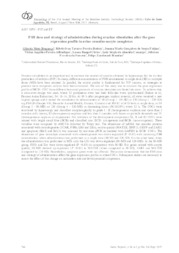FSH dose and strategy of administration during ovarian stimulation alter the gene expression profile in ovine cumulus-oocyte complexes.
FSH dose and strategy of administration during ovarian stimulation alter the gene expression profile in ovine cumulus-oocyte complexes.
Author(s): BRAGANÇA, G. M.; BATISTA, R. I. T. P.; SOUZA FABJAN, J. M. G. de; ALFRADIQUE, V. A. P.; CORTÊS, L. R.; CAMARGO, L. S. de A.; FONSECA, J. F. da; BRANDÃO, F. Z.
Summary: Ovarian stimulation is an important tool to increase the number of oocytes obtained by laparoscopy for the in vitro production of embryos (IVP). In sheep, different concentrations of FSH administered in single dose (SD) or multiple doses (MD) have been adopted. In parallel, the oocyte quality is fundamental for IVP success, so strategies to produce more competent oocytes have been evaluated. The aim of this study was to evaluate the gene expression profile of BCB+ COC from different hormonal protocols of ovarian stimulation in Santa Inês ewes. To achieve that, a cross-over design was used, where 12 pluriparous ewes had their follicular wave synchronized (Balaro et al., Domest Anim Endocrinol, 54: 10-14, 2016). At 80 h after progestogen implant removal, all ewes received a new vaginal sponge and it started the stimulation by administration of: 80 (Group 1 - 80-SD) or 120 (Group 2 - 120-SD) mg FSH (Folltropin-V®, Bioniche Animal Health, Ontario, Canada) and 300 IU of eCG both in single dose, or 80 (Group 3 - 80-MD) or 120 (Group 4 - 120-MD) in decreasing doses (50/30/20%) every 12 h. The COCs were recovered by laparoscopy and classified morphologically in grade I / II (homogeneous ooplasm and more than 3 cumulus cells layers), III (homogeneous ooplasm and less than 3 cumulus cells layers or partially denuded) and IV (heterogeneous ooplasm or degenerate). For inference of the development competence GI, II and III COCs were stained with bright cresyl blue (BCB) and classified into: BCB+ (competent) and BCB- (non-competent). These variables were compared by ANOVA followed by Tukey test. The abundance of mRNA that encodes proteins associated with steroidogenesis (STAR, FSHr, LHr and ER?), oocyte quality (MATER, BMP15, GDF9 and ZAR1) and apoptosis (BAX and Bcl-2) was assessed by real-time qPCR normalized with GAPDH in BCB+ COCs. The abundance of gene transcripts associated with steroidogenesis was down-regulated (P <0.05) with increasing FSH concentration, when administration was performed in a single dose (80-SD and 120-SD). On the other hand, when the administration was performed in MD, only the LHr was down-regulated (80-MD and 120-MD). In the 80-MD group, FSHr and Er? were down-regulated (P <0.05) in comparison with 80-SD. For genes related with oocyte quality, 80-MD showed up-regulation (P <0.05) to MATER (when compared to 80-SD), ZAR1 and MATER (compared to 120-SD). Nonetheless, apoptosis genes were not affected. These data demonstrate that the FSH dose and strategy of administration affect the gene expression profile in ovine COCs. Subsequent studies are necessary to assess the effect of this change on maturation rate and developmental competence.
Publication year: 2017
Types of publication: Abstract in annals or event proceedings
Unit: Embrapa Goats & Sheep
Observation
Some of Embrapa's publications are published as ePub files. To read them, use or download one of the following free software options to your computer or mobile device. Android: Google Play Books; IOS: iBooks; Windows and Linux: Calibre.
Access other publications
Access the Agricultural Research Database (BDPA) to consult Embrapa's full library collection and records.
Visit Embrapa Bookstore to purchase books and other publications sold by Embrapa.

